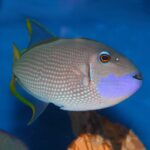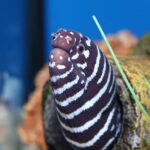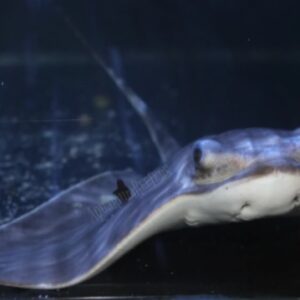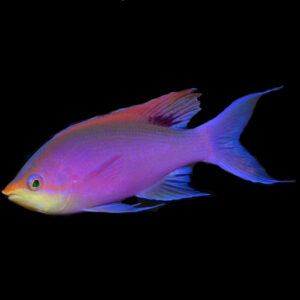Description
The Clown Trigger (Balistoides conspicillum) is a visually striking fish known for its vibrant colouration and unique patterns. It can reach a maximum size of around 20 inches (50 centimetres). The body is dark with bold white spots, and it has a yellow snout, back and fins. The most distinctive feature of the Clown Trigger is its large, prominent, and powerful jaw, which it uses to forage and feed.
Taxonomy:
The Clown Trigger belongs to the family Balistidae, which comprises various triggerfish species. The genus Balistoides is characterized by its robust body shape, distinct colouration, and strong jaws. The Clown Trigger’s closest relatives within the genus include species like the Titan Triggerfish (Balistoides viridescens) and the Red toothed Triggerfish (Balistoides conspicillum).
Natural Habitat:
In its natural habitat, the Clown Trigger can be found in tropical waters of the Indo-Pacific region. It inhabits coral reefs and rocky areas with ample hiding spots and crevices. These areas provide the Clown Trigger with shelter, as well as opportunities for hunting and foraging. It is commonly found at depths ranging from 10 to 100 feet (3 to 30 meters).
Keeping the Clown Trigger Healthy:
The Clown Trigger requires attentive care to ensure its health and well-being. It has a moderate care level and can be a bit challenging to keep due to its specific needs. Providing a large aquarium with plenty of swimming space is essential, as it is an active swimmer. The water temperature should be maintained between 75°F and 82°F (24°C and 28°C), with a pH range of 8.1 to 8.4 and a salinity of 1.020-1.025.
Special Requirements and Feeding:
The Clown Trigger is an omnivorous species but leans more towards a carnivorous diet. It requires a varied diet consisting of high-quality marine-based foods such as shrimp, fish, squid, and crustaceans. Additionally, incorporating some vegetable matter like seaweed or algae-based food is beneficial. Feeding should be done multiple times a day in smaller portions to prevent overeating and maintain optimal health.
How Many Should I Keep?
The Clown Trigger is typically kept as a solitary fish due to its aggressive and territorial nature. It is not recommended to keep multiple Clown Triggers in the same aquarium as they are likely to engage in aggressive behaviour towards each other.
Lighting Preference:
The Clown Trigger does not have specific lighting preferences and can adapt well to various lighting conditions commonly found in reef aquarium setups.
Suitable Tank Mates:
When considering tank mates for the Clown Trigger, it is important to choose species that can withstand its aggressive behaviour. Avoid keeping it with smaller, more delicate fish or invertebrates that may become targets. Compatible tank mates may include larger, robust fish species that can hold their own in the aquarium.
Reproduction in the Wild:
In the wild, the Clown Trigger (Balistoides conspicillum) follows a unique reproductive process. During courtship, the male performs a captivating behaviour known as the “wiggle dance.” This dance involves the male vigorously shaking its body while swimming in circles around the female. The purpose of this display is to attract the female and initiate the spawning process.
Breeding Balistoides conspicillum:
Breeding Clown Triggers in captivity can be a challenging endeavour due to their aggressive nature and specific requirements. Here’s a detailed breakdown of the breeding process:
- Set up:
Prepare a spacious breeding tank with suitable water parameters. Maintain the temperature between 78°F and 82°F (25°C and 28°C) and ensure pristine water quality.
- Courtship/Spawning:
Introduce a mature male and female Clown Trigger into the breeding tank. The male will perform the wiggle dance to attract the female’s attention. Once courtship is successful, the female will release a large number of eggs, which the male will fertilize externally.
- Rearing:
After spawning, the eggs should be carefully collected and transferred to a separate rearing tank with appropriate conditions. The eggs typically hatch within a few days, and the newly hatched larvae will require specialized care and nutrition. Providing them with live, small, and nutritious prey such as copepods and brine shrimp is crucial for their development.
Sexual Dimorphism:
There is minimal sexual dimorphism in the Clown Trigger. Both males and females exhibit similar body shapes, colouration, and patterns, making it challenging to visually distinguish between them.
Distribution:
The Clown Trigger, Balistoides conspicillum, is naturally distributed in the Indo-Pacific region, including areas such as the Red Sea, the Maldives, and the Great Barrier Reef. While there may be captive-bred and line-bred strains of Clown Triggers available in the aquarium trade, the original wild fish originate from these Indo-Pacific regions.
Summary:
The Clown Trigger (Balistoides conspicillum) is a unique and fascinating fish species known for its vibrant colouration, aggressive nature, and specific care requirements. Breeding these fish in captivity can be challenging, requiring careful setup, successful courtship, and dedicated care for the eggs and larvae. While there is minimal sexual dimorphism, both males and females exhibit striking patterns and colours. The Clown Trigger is naturally found in the Indo-Pacific region and is an impressive addition to a well-maintained aquarium.
The Fish pictured here are representative only and the livestock you receive may vary in pattern, coloration, and shape.








